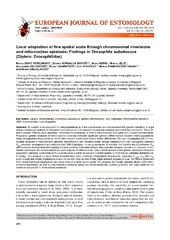Приказ основних података о документу
Local adaptation at fine spatial scale through chromosomal inversions and mito-nuclear epistasis: Findings in Drosophila subobscura (Diptera: Drosophilidae)
| dc.creator | Savić Veselinović, Marija | |
| dc.creator | Kurbalija Novičić, Zorana | |
| dc.creator | Kenig, Bojan | |
| dc.creator | Jelić, Mihailo | |
| dc.creator | Patenković, Aleksandra | |
| dc.creator | Tanasković, Marija | |
| dc.creator | Pertoldi, Cino | |
| dc.creator | Stamenković-Radak, Marina | |
| dc.creator | Anđelković, Marko | |
| dc.date.accessioned | 2020-05-14T11:08:12Z | |
| dc.date.available | 2020-05-14T11:08:12Z | |
| dc.date.issued | 2019 | |
| dc.identifier.issn | 1802-8829 | |
| dc.identifier.uri | http://www.eje.cz/doi/10.14411/eje.2019.051.html | |
| dc.identifier.uri | https://radar.ibiss.bg.ac.rs/handle/123456789/3669 | |
| dc.description.abstract | To explore local adaptation in wild populations at a fine spatial scale we characterized the genetic variability of eight closely located populations of Drosophila subobscura and its associations with microhabitat environmental conditions. Three different genetic markers were assessed: chromosomal inversions, a SNP of mitochondrial ND5 gene and nuclear microsatellites. Population genetic analyses of chromosomal variability revealed significant genetic differentiation between these populations. Gene arrangement frequencies on the E chromosome contributed most to these differences. We also investigated role of mito-nuclear epistasis in mitochondrial genome differentiation and revealed weak linkage disequilibrium (LD) exclusively between O3+4 inversion arrangement and mitochondrial DNA haplotype I in two populations. In addition, the trend in the LD between OST chromosomal arrangement and haplotype II was general in the total sample. Microsatellite analysis revealed an absence of stochastic processes, like census reduction, upon population differentiation. Only a small amount of the genetic variation is related to geographic distance, while most (97%) is attributable to other factors and in some degree to microhabitat variables (temperature, humidity). The analysis of these factors revealed they effect inversion arrangement frequencies, especially E1+2+9, EST and OST. Even though this model organism is known for its high mobility and mostly large effective population size, the results presented here reveal that local adaptations can occur even at a small spatial scale. We propose that locally adapted alleles within chromosomal inversions, as well as joint selective pressures acting on mitochondrial and nuclear genomes, are responsible for the observed adaptation to microhabitat conditions. | en |
| dc.publisher | Biology Centre, AS CR | |
| dc.relation | info:eu-repo/grantAgreement/MESTD/Basic Research (BR or ON)/173012/RS// | |
| dc.relation | Serbian Academy of Sciences and Arts under strategic projects programme – grant agreement No 03-2019 | |
| dc.rights | openAccess | |
| dc.rights.uri | https://creativecommons.org/licenses/by/4.0/ | |
| dc.source | European Journal of Entomology | |
| dc.subject | Diptera | |
| dc.subject | Drosophila subobscura | |
| dc.subject | Drosophilidae | |
| dc.subject | ND5 | |
| dc.subject | Chromosomal inversion | |
| dc.subject | Genetic differentiation | |
| dc.subject | High dispersion | |
| dc.subject | Local adaptation | |
| dc.subject | Microsatellites | |
| dc.title | Local adaptation at fine spatial scale through chromosomal inversions and mito-nuclear epistasis: Findings in Drosophila subobscura (Diptera: Drosophilidae) | en |
| dc.type | article | en |
| dc.rights.license | BY | |
| dcterms.abstract | Пертолди, Цино; Кениг, Бојан; Савић Веселиновић, Марија; Јелић, Михаило; Aнђелковић, Марко; Стаменковић-Радак, Марина; Курбалија Новичић, Зорана; Патенковић, Aлександра; Танасковић, Марија; Лоцал адаптатион ат фине спатиал сцале тхроугх цхромосомал инверсионс анд мито-нуцлеар епистасис: Финдингс ин Дросопхила субобсцура (Диптера: Дросопхилидае); | |
| dc.rights.holder | © Institute of Entomology, Biology Centre, Czech Academy of Sciences, Ceské Budejovice 2020. | |
| dc.citation.issue | 1 | |
| dc.citation.volume | 116 | |
| dc.identifier.doi | 10.14411/eje.2019.051 | |
| dc.identifier.scopus | 2-s2.0-85084254323 | |
| dc.identifier.wos | 000505163300005 | |
| dc.citation.apa | Savic Veselinovic, M., Kurbalija Novicic, Z., Kenig, B., Jelic, M., Patenkovic, A., Tanaskovic, M., et al. (2019). Local adaptation at fine spatial scale through chromosomal inversions and mito-nuclear epistasis: Findings in Drosophila subobscura (Diptera: Drosophilidae). European Journal of Entomology, 116(1), 492–503. | |
| dc.citation.vancouver | Savic Veselinovic M, Kurbalija Novicic Z, Kenig B, Jelic M, Patenkovic A, Tanaskovic M, Pertoldi C, Stamenkovic-Radak M, Andjelkovic M. Local adaptation at fine spatial scale through chromosomal inversions and mito-nuclear epistasis: Findings in Drosophila subobscura (Diptera: Drosophilidae). Eur J Entomol. 2019;116(1):492–503. | |
| dc.citation.spage | 492 | |
| dc.citation.epage | 503 | |
| dc.type.version | publishedVersion | |
| dc.identifier.fulltext | https://radar.ibiss.bg.ac.rs/bitstream/id/6175/bitstream_6175.pdf | |
| dc.citation.rank | M22 |

